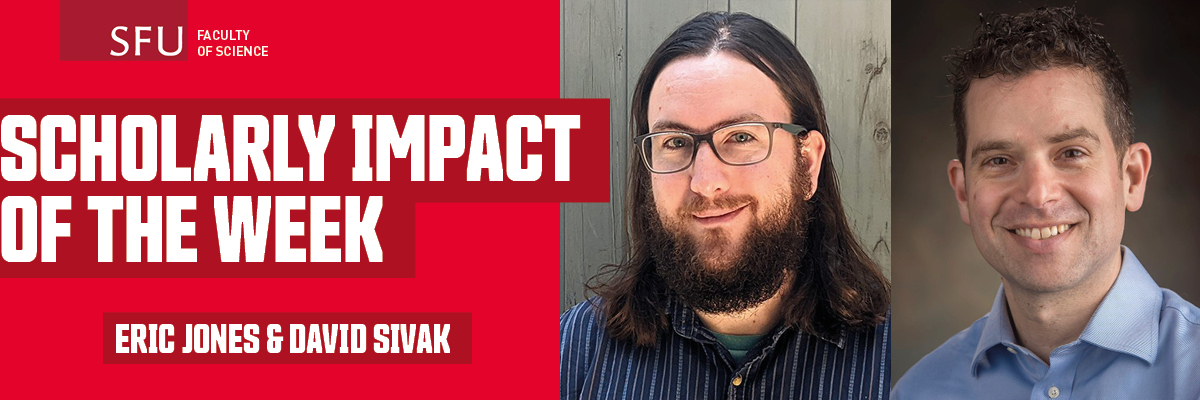
Everyone has a gut microbiome, full of trillions of microbes that influence our health. These microscopic populations help us metabolize food, train our immune system and might even affect our mood. According to researchers, everyone’s microbiome is different—of the trillions of organisms that reside in the gut, every individual has a unique combination. How do people acquire their personalized gut microbiome? And how can people change their gut microbiome to become healthier?
Researchers at Simon Fraser University (SFU) set out to answer these questions. Physics Professor and Canada Research Chair in Nonequilibrium Statistical Biophysics David Sivak leads the Sivak Group at SFU. His research intersects with molecular biology and biochemistry, chemistry and mathematics and uses an interdisciplinary approach to study the physical limitations of complex biological systems.
Sivak works with Postdoctoral Fellow Eric Jones, a quantitative ecologist and statistical physicist who received Banting and PIMS fellowships to study “medicine for the microbiome.” They collaborated with William Ludington from the Carnegie Institution for Science and Jean Carlson from the University of California, Santa Barbara on their latest work, Stochastic microbiome assembly depends on context.
In the study led by Jones, the researchers used a controlled environment to examine how fruit flies acquire their gut microbiome. They discovered that within identical fly communities consuming the same bacteria-laced food, bacterial colonization was not guaranteed—that is, sometimes bacteria stick to the gut and other times they do not. Some bacterial species are better at colonizing than other species, and interactions between species affect whether a particular bacterial species is accepted into the mix.
Mathematical modeling then enabled them to expand the scope beyond fruit flies to theorize how human beings assemble their own vast populations of gut bacteria. These research findings have implications for how humans might introduce microbes into their own gut microbiome through diets, probiotics or fecal transplants. They also set the stage for advancing towards the eventual goal of personalized microbiome medicine.
We talked with Jones and Sivak about their research.
Can you describe how you went about the experiment? How does physics intersect with microbiology in this type of work?
Researchers in the Ludington group carefully sterilized fruit flies at birth to eliminate all the bacteria in their guts, fed them particular combinations of bacterial species, and 10 days later measured which bacterial species managed to colonize the flies and which ones did not. We applied our statistical physics background to make sense of this vast dataset, consisting of bacterial colonization data from thousands of flies. There was no existing theory for this microbiome acquisition process, so in accordance with our physics training we looked for patterns in the data and developed the simplest mathematical framework that explained the data. The key was to appreciate that identically prepared experimental replicates were not identically colonized by bacteria! It was essential to use probabilistic methods to describe and interpret this variability.
How did you make the connection between fruit fly gut bacteria and human gut bacteria?
Ultimately, we are interested in understanding how the human gut microbiome can be leveraged to improve human health, but basic science research studying the fruit fly microbiome is an essential first step. The fruit fly gut microbiome is a tractable experimental system that is similar to and simpler than the human gut microbiome—the fruit fly microbiome consists of dozens of bacterial species, while the human microbiome consists of thousands. Several of the bacterial species that we used in our experiments are also found in humans. The rules for bacterial colonization in humans are probably similar to the rules of colonization in flies, and we expect our mathematical framework to be more or less generalizable across organisms.
Can you describe some of the implications for a better understanding of the human gut microbiome?
There is significant medical interest in the idea that modifying a person’s gut microbiome in deliberate ways (for example by taking probiotics, receiving a fecal transplant, or modifying their diet) can lead to microbe-mediated health benefits. The most obvious success is the ability of fecal microbiota transplantation (FMT)—a treatment where “healthy” microbes are transplanted into a sick person’s gut—to cure C. difficile infection. For both probiotics and FMT, it is crucial that the ingested bacterial species stably engraft, that is, that the bacteria successfully stick in the gut and multiply. By analyzing the engraftment of bacteria in germ-free flies, we learn lessons about which types of species will best colonize a person’s gut, and how to construct synthetic microbial communities that maximize the colonization odds of all species.
Is there anything we should all be doing right now to keep our gut healthy?
Though outside the scope of our study, two relevant findings for human health are first, people who have diverse gut microbiomes consisting of many bacterial species tend to be healthier and second, eating fermented and high-fiber foods has been found to increase gut microbiome diversity and decrease inflammation in people.
SFU's Scholarly Impact of the Week series does not reflect the opinions or viewpoints of the university, but those of the scholars. The timing of articles in the series is chosen weeks or months in advance, based on a published set of criteria. Any correspondence with university or world events at the time of publication is purely coincidental.
For more information, please see SFU's Code of Faculty Ethics and Responsibilities and the statement on academic freedom.